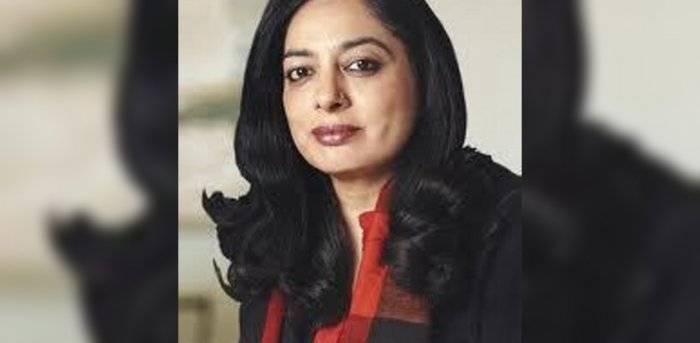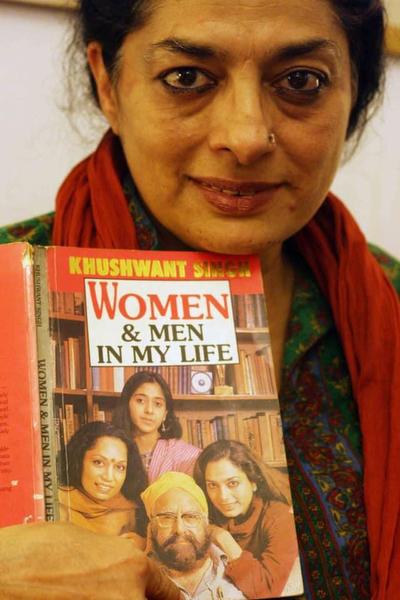
You sit down to write a requiem for a friend. It turns into a lament for a city, a time lost: a time of beauty; elegance, erudition, elegance, spaciousness. Lost, forever...
My friend Sadia Dehlvi passed into the ether this August 5. Buried much with her: thirty two years of my youth, memories of many sun drenched afternoons on the expansive lawns of her sprawling glittering Shama Kothi home locals had dubbed Dilli ka Tajmahal ; reading Faiz together with the polymath Suharwardy sahib, listening spellbound in the moonlight to the flirtatious Pakistani poet Ahmed Faraz reciting “Suna hai log usey aankh bhar ke dehtey hain/ So uskey sheher mein kuch din theher ke dekhtey hain” to my beauteous friend sitting there with the air of a Queen receiving tribute, laughing as the vivacious writer Tehmina Durrani regaled us with stories of assorted feudal lords across the border that strutted about Kalashnikov wielding bodyguards in tow, stuffing our faces with melt in the mouth kakori kebabs from Sadia’s legendary Al Kausar kiosk across the road from the house that was the favoured go-to destination of Delhi gourmands, movers and shakers, visiting film stars, diplomats in her Chanakyapuri neighborhood.
I thought of nothing while turning my bike after a late night shift at the Express and dropping by well past midnight to be part of Sadia soiree’s that extended well into the small hours of the morning; demanding food and drink that was generously magically produced, lovingly served to me.
 Did it ever strike anyone as odd that Sadia was an incredibly attractive young woman; that I, her bum chum was a single thirty year old? That she was Muslim? That I was Hindu? That her salon featured me, innumerable other questing souls? Of varying ages, faiths, persuasions? All we knew was that we shared a passion for food, books, poetry, Urdu, beauty. And Delhi.
Did it ever strike anyone as odd that Sadia was an incredibly attractive young woman; that I, her bum chum was a single thirty year old? That she was Muslim? That I was Hindu? That her salon featured me, innumerable other questing souls? Of varying ages, faiths, persuasions? All we knew was that we shared a passion for food, books, poetry, Urdu, beauty. And Delhi.
The year 1990 was tumultuous. The violence that preceded and surrounded Babri Masjid was a distant nightmare. Yet, it was a fractured dawn that opened the millennium for us. Camelot was over. Rajiv Gandhi had been assassinated in 1991. The 1987 unlocking of the Babri Masjid followed by the Advani rath yatra had led up to a cataclysm. Babri Masjid’s demolition was followed by the bloody India-wide riots, the deadly Mumbai blasts which tore apart the very fabric of the country, not the City of Gold alone and forever changed the Delhi Sadia and I had known and loved. Saffron became the code and colour of the New Establishment. Hundred headed Hydras roamed the ravaged land, erstwhile journalist colleagues mutated overnight into aggressive apologists, handmaidens of the new Establishment. Civic discourse coarsened, dialogue between contending believers faltered, then ceased. Sadia went to many television debates only to come home and despair at the tone, the tenor of the argument.
The lights dimmed somewhat at Shama Kothi. The nation fractured. So did Sadia’s family. Her family sold the fabled house. She moved to Nizamuddin- it comforted her. In this cocoon next to her beloved patron saint’s mazaar, the place of syncretic devotion for millennia, she felt safe. The evenings acquired another dimension reminiscent of Brecht where a character asks about the dark times “...Will there be singing? Yes, there will also be singing. About the bad times.” Sufi strains rang out of that Nizamuddin flat. Her son Armaan, a dhrupadiya invoked Shiva, Dhruv Sangari mellifluously channeled Nizamuddin Auliya, visiting Iranian musicians often kept the beat.
The brief reprieve of UPA 1 gave way to the sorry drift of UPA 2 that culminated in the ringing arrival of The New Era. Delhi, India, as we knew it ceased to exist. Irrevocable it was. On the train from Saharanpur, Sadia’s panic stricken brother rushed to prevent Sadia from eating a mutton kaathi kebab snack. A “friend” told her “But you Muslims are quite fundoo, no?” while an erudite professionally eminent relative taunted me asking “why I was so ashamed of being Hindu” and declared rhetorically he didn’t mind “ if we became a Hindu rashtra” while I stood there stunned, speechless. Things one took for granted in Delhi: the lack of narrow provincialism with its marked divisions of religion/ caste; the easy cosmopolitanism, the relaxed urbanity, the reflexive belief in beliefs being a private not a public matter, were a thing of the past.
Sadia threw herself into a study of the past to better make sense of the present. A book and a documentary on Sufism followed. The seething helpless anger at the unfolding dystopian horror gave way to a genuine quest to understand the combative tone, searching conciliatory one on TV. Often we despaired. The Delhi riots broke her, us both. But then there was food, music, her compelling joi de vivre, her incredible ability to laugh. Like her Beloved City that had reimagined itself nine times over, reason too, would prevail. One day. Soon.
She couldn’t live to see that day. The cancer that ravaged the body politic raged in her body now. My friend bravely fought for twenty one long months before her tired body capitulated. So much died with this friend I loved. Memories of a happier, more hopeful time. They carried her out as she wished to the sound of Dhruv singing Khusrau:
Mohey apne hi rang mein rang do Nijaam
Tu hai Sahib mera, Mehboob e Ilahi
May the Saint she adored be the salve to her soul . And the salvation of the wounded city she loved.
A shorter version of this article appeared in Outlook India
My friend Sadia Dehlvi passed into the ether this August 5. Buried much with her: thirty two years of my youth, memories of many sun drenched afternoons on the expansive lawns of her sprawling glittering Shama Kothi home locals had dubbed Dilli ka Tajmahal ; reading Faiz together with the polymath Suharwardy sahib, listening spellbound in the moonlight to the flirtatious Pakistani poet Ahmed Faraz reciting “Suna hai log usey aankh bhar ke dehtey hain/ So uskey sheher mein kuch din theher ke dekhtey hain” to my beauteous friend sitting there with the air of a Queen receiving tribute, laughing as the vivacious writer Tehmina Durrani regaled us with stories of assorted feudal lords across the border that strutted about Kalashnikov wielding bodyguards in tow, stuffing our faces with melt in the mouth kakori kebabs from Sadia’s legendary Al Kausar kiosk across the road from the house that was the favoured go-to destination of Delhi gourmands, movers and shakers, visiting film stars, diplomats in her Chanakyapuri neighborhood.
I thought of nothing while turning my bike after a late night shift at the Express and dropping by well past midnight to be part of Sadia soiree’s that extended well into the small hours of the morning; demanding food and drink that was generously magically produced, lovingly served to me.
 Did it ever strike anyone as odd that Sadia was an incredibly attractive young woman; that I, her bum chum was a single thirty year old? That she was Muslim? That I was Hindu? That her salon featured me, innumerable other questing souls? Of varying ages, faiths, persuasions? All we knew was that we shared a passion for food, books, poetry, Urdu, beauty. And Delhi.
Did it ever strike anyone as odd that Sadia was an incredibly attractive young woman; that I, her bum chum was a single thirty year old? That she was Muslim? That I was Hindu? That her salon featured me, innumerable other questing souls? Of varying ages, faiths, persuasions? All we knew was that we shared a passion for food, books, poetry, Urdu, beauty. And Delhi.The year 1990 was tumultuous. The violence that preceded and surrounded Babri Masjid was a distant nightmare. Yet, it was a fractured dawn that opened the millennium for us. Camelot was over. Rajiv Gandhi had been assassinated in 1991. The 1987 unlocking of the Babri Masjid followed by the Advani rath yatra had led up to a cataclysm. Babri Masjid’s demolition was followed by the bloody India-wide riots, the deadly Mumbai blasts which tore apart the very fabric of the country, not the City of Gold alone and forever changed the Delhi Sadia and I had known and loved. Saffron became the code and colour of the New Establishment. Hundred headed Hydras roamed the ravaged land, erstwhile journalist colleagues mutated overnight into aggressive apologists, handmaidens of the new Establishment. Civic discourse coarsened, dialogue between contending believers faltered, then ceased. Sadia went to many television debates only to come home and despair at the tone, the tenor of the argument.
The lights dimmed somewhat at Shama Kothi. The nation fractured. So did Sadia’s family. Her family sold the fabled house. She moved to Nizamuddin- it comforted her. In this cocoon next to her beloved patron saint’s mazaar, the place of syncretic devotion for millennia, she felt safe. The evenings acquired another dimension reminiscent of Brecht where a character asks about the dark times “...Will there be singing? Yes, there will also be singing. About the bad times.” Sufi strains rang out of that Nizamuddin flat. Her son Armaan, a dhrupadiya invoked Shiva, Dhruv Sangari mellifluously channeled Nizamuddin Auliya, visiting Iranian musicians often kept the beat.
The brief reprieve of UPA 1 gave way to the sorry drift of UPA 2 that culminated in the ringing arrival of The New Era. Delhi, India, as we knew it ceased to exist. Irrevocable it was. On the train from Saharanpur, Sadia’s panic stricken brother rushed to prevent Sadia from eating a mutton kaathi kebab snack. A “friend” told her “But you Muslims are quite fundoo, no?” while an erudite professionally eminent relative taunted me asking “why I was so ashamed of being Hindu” and declared rhetorically he didn’t mind “ if we became a Hindu rashtra” while I stood there stunned, speechless. Things one took for granted in Delhi: the lack of narrow provincialism with its marked divisions of religion/ caste; the easy cosmopolitanism, the relaxed urbanity, the reflexive belief in beliefs being a private not a public matter, were a thing of the past.
Sadia threw herself into a study of the past to better make sense of the present. A book and a documentary on Sufism followed. The seething helpless anger at the unfolding dystopian horror gave way to a genuine quest to understand the combative tone, searching conciliatory one on TV. Often we despaired. The Delhi riots broke her, us both. But then there was food, music, her compelling joi de vivre, her incredible ability to laugh. Like her Beloved City that had reimagined itself nine times over, reason too, would prevail. One day. Soon.
She couldn’t live to see that day. The cancer that ravaged the body politic raged in her body now. My friend bravely fought for twenty one long months before her tired body capitulated. So much died with this friend I loved. Memories of a happier, more hopeful time. They carried her out as she wished to the sound of Dhruv singing Khusrau:
Mohey apne hi rang mein rang do Nijaam
Tu hai Sahib mera, Mehboob e Ilahi
May the Saint she adored be the salve to her soul . And the salvation of the wounded city she loved.
A shorter version of this article appeared in Outlook India
